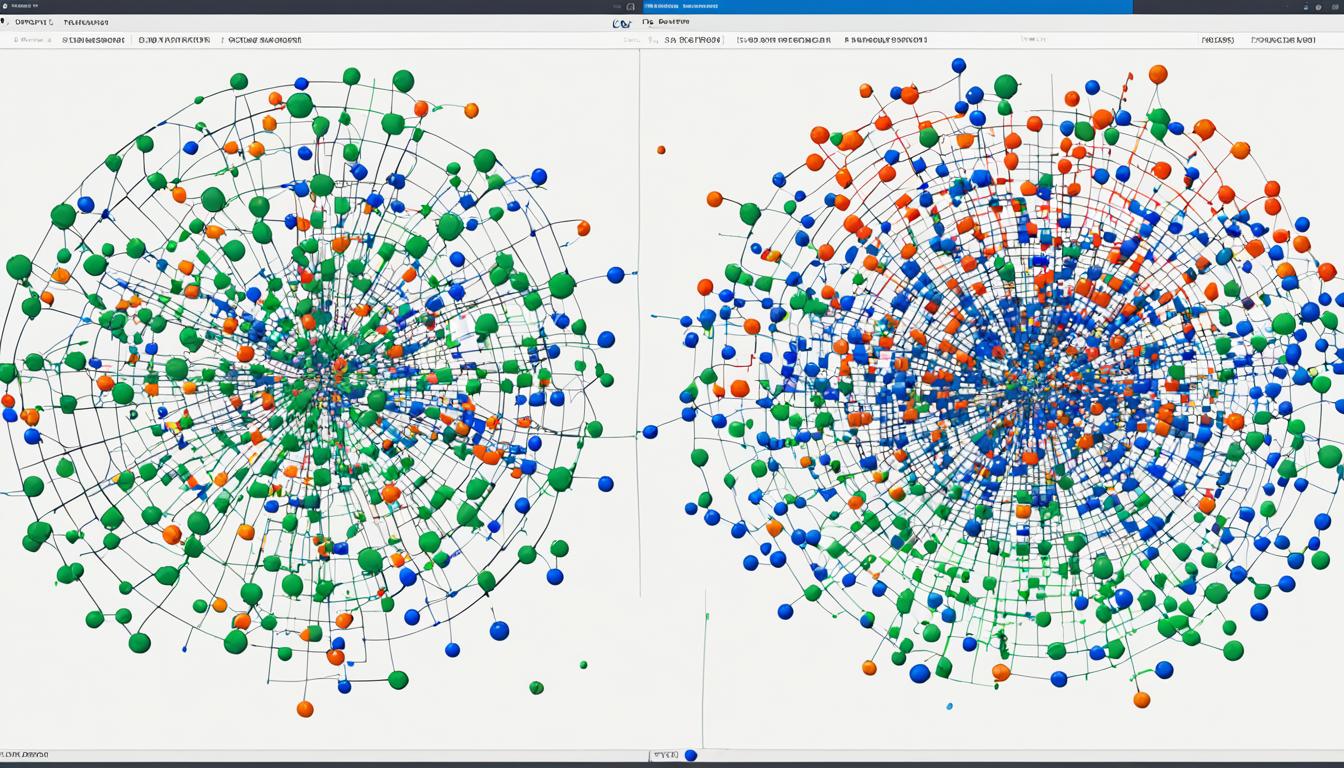Nagios vs. Observium: IT Monitoring Compared
When it comes to network monitoring tools, there are plenty of options available. But which one is the best choice for your organization? In this article, we will dive into the world of Nagios and Observium, two popular network monitoring tools, and compare their features, performance, and suitability for enterprise monitoring and network management. So, are you ready to find out which is better: Nagios or Observium?
Key Takeaways:
- Nagios and Observium are both powerful network monitoring tools, but they have key differences.
- Nagios is an open-source tool that requires complex configurations and is best suited for experienced Linux engineers.
- Observium offers a comprehensive network monitoring platform with a robust feature set for network administrators.
- The choice between Nagios and Observium depends on your specific requirements, network environment, and level of expertise.
- Consider factors such as features, support, usability, and scalability when selecting the right tool for your network management needs.
Overview of Nagios
Nagios is a powerful network monitoring tool that excels in managing mission-critical applications. Built specifically for the Linux environment, Nagios offers a comprehensive solution for monitoring network activities and ensuring the smooth operation of your systems. Its extensive range of Linux-based plugins further enhances its capabilities, providing unparalleled flexibility and control.
With Nagios, you can monitor your network in real-time, detecting potential issues before they escalate into major disruptions. This proactive approach is crucial for organizations relying on mission-critical applications that demand uninterrupted performance. By leveraging Nagios’ open-source components, such as MySQL, Grafana, and NRDP, you can maximize the tool’s monitoring potential and tailor it to meet your specific needs.
Deploying Nagios does require some expertise, as it entails complex configurations and installations. However, with experienced Linux engineers at hand, these challenges can be overcome, enabling you to set up a robust network monitoring system. This level of customization, along with Nagios’ compatibility with open-source components, makes it a versatile solution for network monitoring in Linux-based environments.
Listed below are the key features of Nagios:
- Real-time network monitoring
- Linux-based plugins for extensive customization
- Support for mission-critical applications
- Open-source components integration for enhanced capabilities
With Nagios as your network monitoring tool, you can maintain a reliable and secure environment for your mission-critical applications in the Linux ecosystem.
“Nagios is a powerful network monitoring tool that offers unparalleled flexibility and control. Its compatibility with the Linux environment and extensive range of plugins makes it an excellent choice for mission-critical applications. With Nagios, you can proactively monitor your network, ensuring optimal performance and minimizing downtime.”
Pros of Nagios
When it comes to monitoring services, hardware, and devices, Nagios has several key advantages that make it an excellent choice for your IT management needs.
Notification
Nagios provides real-time notifications to key staff, ensuring a quick response to issues. With its robust notification system, you can rest assured that any potential problems will be promptly addressed, minimizing downtime and keeping your network running smoothly.
Automatic Device Discovery
One of the standout features of Nagios is its automatic device discovery. This functionality saves you time and effort by automatically detecting and adding devices to your monitoring system. It eliminates the need for manual configuration, making device management simpler and more efficient.
Scalability
Nagios is highly scalable, allowing you to monitor an extensive array of devices and services. Whether you are a small business or a large enterprise, Nagios can accommodate your needs and grow alongside your network infrastructure. Its scalability ensures that you can effectively monitor and manage your expanding IT environment without limitations.
Real-Time Monitoring
With Nagios, you can monitor your network in real-time, gaining immediate insights into the status and performance of your services and devices. Real-time monitoring empowers you to detect and resolve issues as they arise, preventing any potential disruptions to your network operations.
Overall, Nagios offers a comprehensive set of features that enable efficient monitoring of your IT infrastructure. From its notification capabilities and automatic device discovery to its scalability and real-time monitoring, Nagios equips you with the tools you need to ensure optimal performance and reliability.
Cons of Nagios
While Nagios offers numerous benefits, it is essential to consider its drawbacks. Some users have expressed the need for core improvements, particularly in the areas of high availability (HA) and the web GUI. Although Nagios is easy to set up, it can be complex to fully customize to meet specific requirements.
Documentation and community support are also areas that some users believe could be enhanced. While Nagios provides resources for configuration and troubleshooting, there is room for improvement in terms of comprehensive and user-friendly documentation.
Furthermore, although Nagios offers a high level of flexibility, customization can be time-consuming and challenging, requiring advanced technical expertise. This may pose a difficulty for users who are new to the system or have limited technical knowledge.
Despite these limitations, Nagios remains a robust network monitoring tool, favored by many IT professionals for its extensive capabilities and reliability.
Likelihood to Recommend Nagios
Based on user feedback, Nagios is highly recommended for organizations looking for a stable and reliable network monitoring solution. Its robust features and versatility make it particularly well-suited for companies that manage a large number of servers and services.
Users have found that by consolidating multiple unique network monitoring solutions into a single platform like Nagios, they are able to streamline their operations and improve overall efficiency. This integrated approach ensures comprehensive monitoring and simplifies the management of network infrastructure.
Whether it’s for monitoring hardware, services, or devices, Nagios provides a customizable solution that meets the diverse needs of different organizations. Its powerful notification system enables quick response to any issues that may arise, allowing IT teams to proactively address network problems.
Moreover, Nagios offers real-time monitoring capabilities, scalability options, and automatic device discovery, further enhancing its ability to deliver accurate and reliable network monitoring.
Combining multiple network monitoring solutions into a single platform like Nagios has helped us streamline our operations, improve efficiency, and ensure comprehensive network monitoring across our infrastructure. The customizable nature of Nagios allows us to tailor the solution to our specific needs, making it an invaluable tool for our organization.
In conclusion, Nagios stands out as a highly recommended choice for companies seeking a stable and versatile network monitoring solution. By consolidating multiple unique network monitoring solutions into a single platform, organizations can achieve comprehensive monitoring and enjoy the benefits of streamlined operations and improved efficiency.
Continue reading to explore the pros and cons of Observium, another popular network monitoring tool, in section 6 of this article.
Overview of Observium
Observium is a comprehensive network monitoring platform specifically designed for network administrators to effectively manage their network infrastructure. With its user-friendly interface and powerful features, Observium is an ideal solution for monitoring network performance and ensuring optimal network functionality.
One of the standout features of Observium is its support for multiple platforms, including Windows, SaaS, web, iPhone, Android, and Chromebook. This versatility allows network administrators to monitor their networks from various devices, providing convenience and flexibility.
To further enhance its functionality, Observium offers an API that allows seamless integration with other systems. This API enables network administrators to automate tasks and access data from Observium, streamlining their workflow and improving efficiency.
Observium also provides extensive documentation, support, and training resources for users to get the most out of the platform. Whether you are a beginner or an experienced network administrator, Observium offers the resources you need to successfully navigate and utilize its features.
To give users a better understanding of its capabilities, Observium offers screenshots and videos that showcase its various features. This visual representation helps users visualize and comprehend the data and insights provided by Observium, making it easier to analyze and troubleshoot network issues.
Overall, Observium is a robust network monitoring platform that empowers network administrators to effectively monitor and manage their network infrastructure. With its support for multiple platforms, API integration, and abundance of support resources, Observium is a valuable tool for network administrators seeking a comprehensive monitoring solution.
I find Observium to be an invaluable tool for network monitoring. Its support for multiple platforms, extensive documentation, and API integration have significantly improved our network management efficiency. The screenshots and videos provided by Observium help us quickly identify and resolve any network issues. I highly recommend Observium to all network administrators.
Next Steps: Comparing the Pros and Cons
Now that we’ve explored the overview of Observium, let’s delve deeper into its pros and cons. In the next section, we will highlight the key advantages and disadvantages of using Observium as a network monitoring platform.
Pros of Observium
Observium offers several key advantages that make it a valuable tool for monitoring services and devices in IT environments.
1. Monitoring Services and Devices
Observium excels at monitoring a wide range of services and devices within your network infrastructure. Whether it’s tracking the performance of your servers, switches, routers, or other critical network components, Observium provides comprehensive visibility into your IT ecosystem. This enables you to proactively identify and address potential issues before they impact your operations.
2. Notifications for Quick Response
With Observium, you can set up customizable notification alerts to receive instant updates on any changes or anomalies detected within your network. These notifications enable you and your team to take immediate action to resolve issues, minimizing downtime and ensuring smooth operations.
3. Usability
Observium offers a user-friendly interface that makes it easy to navigate and access the key features and functionalities. The intuitive design and layout enhance user experience, allowing network administrators to monitor and manage their IT infrastructure efficiently.
4. Training Resources
Observium provides ample training resources to help users familiarize themselves with the tool and maximize its potential. Whether it’s user guides, video tutorials, or online forums, Observium ensures that users have the necessary support and knowledge to leverage the tool effectively. This empowers network administrators to get up to speed quickly and take full advantage of Observium’s capabilities.
By leveraging Observium’s extensive monitoring services, real-time notifications, user-friendly interface, and helpful training resources, network administrators can gain valuable insights into their IT infrastructure, react promptly to issues, and optimize their network performance.
Cons of Observium
While Observium offers many benefits for network monitoring, it’s important to consider some of the drawbacks mentioned by users. These cons mainly revolve around limitations in its feature set, support, pricing, and alternative options.
Feature Set Limitations
Some users have pointed out that Observium may have limitations in terms of its feature set. While it provides comprehensive monitoring for services and devices, there may be certain specific functionalities or integrations that are not available in Observium’s offering. It’s essential to thoroughly evaluate your requirements and determine if Observium meets your organization’s specific needs.
Support Concerns
Another aspect to consider is the support provided by Observium. While the tool offers various support channels, including community forums and documentation, some users have reported challenges in terms of timely and adequate assistance. It’s important to weigh the level of support you require against the support services provided by Observium.
Non-Transparent Pricing
Pricing information for Observium is not readily available to potential users. This lack of transparency can make it difficult for organizations to evaluate and compare the cost of implementing Observium as part of their network monitoring solution. It’s crucial to consider your budget and explore alternatives in order to make an informed decision.
Exploring Alternatives
When considering Observium, it’s important to evaluate and compare it against other network monitoring tools in the market. This will help you gain a broader perspective on available options and determine if Observium aligns with your specific requirements. Some popular alternatives to Observium include Nagios, Zabbix, and PRTG Network Monitor.

Overall, while Observium provides valuable network monitoring features, it’s important to be aware of the mentioned cons. Evaluating the limitations in its feature set, the level of support provided, pricing concerns, and suitable alternatives will enable you to make an informed decision that best fits your organization’s network monitoring needs.
Likelihood to Recommend Observium
After using Observium for network monitoring, I strongly recommend it as a comprehensive and reliable tool. It offers a robust feature set that sets it apart from other options in the market.
Observium provides extensive network monitoring capabilities, allowing you to monitor your network infrastructure with ease. Its intuitive interface and user-friendly design make it accessible to both experienced and novice network administrators.
“I have been using Observium for network monitoring for quite some time now, and it has greatly simplified the management of our network. The features and visualizations it offers are exceptional, making it a complete parallel to other tools in the market.”
With Observium, you can gain valuable insights into your network’s performance, identify bottlenecks, and proactively address issues before they impact your operations. It enables real-time monitoring, ensuring that you have up-to-date information at your fingertips.
Furthermore, Observium’s customizable notifications allow you to receive alerts promptly, empowering you to take swift action to resolve any network-related problems. Its powerful features and ease of use make it a preferred choice for many network administrators.
Feature Highlights of Observium:
- Comprehensive network monitoring capabilities
- User-friendly interface and design
- Real-time monitoring and performance insights
- Customizable notifications for prompt issue resolution
In conclusion, if you are looking for a reliable and feature-rich network monitoring solution, Observium is the ideal choice. Its complete parallel to other tools in the market, combined with its visualizations and ease of use, makes it a valuable asset for any organization.
Conclusion
In conclusion, when it comes to IT monitoring, both Nagios and Observium are powerful network management tools that offer a range of features and benefits. The decision of which tool is the best fit for your organization will depend on your specific requirements and preferences.
To determine the most suitable solution, consider factors such as the nature of your network environment, the level of expertise available, and the desired features and support. Evaluating these criteria will help you make an informed choice that aligns with your network management needs.
Whether you need a monitoring tool for mission-critical applications in a Linux environment or require a comprehensive network monitoring platform with support for various platforms, Nagios and Observium can both be viable options.
Ultimately, the best choice will depend on your specific circumstances. Take the time to carefully evaluate your options, considering the merits of both Nagios and Observium, to ensure you select the network monitoring tool that best meets your organization’s network management requirements.
For further information and to explore additional resources on Nagios and Observium, visit their official websites. These resources provide documentation, training materials, and community support to assist you in implementing effective network monitoring and IT management solutions.
Additional Resources
For more information on Nagios and Observium, visit their official websites:
- Nagios – https://www.nagios.com/
- Observium – https://www.observium.org/
These resources offer valuable insights and tools to help you make an informed decision about your network monitoring needs, empowering you to maximize the effectiveness of your IT management practices.
Additional Resources
For additional resources and information on Nagios and Observium, you can visit the official websites of both tools. These websites provide valuable documentation, training materials, and community support to help you dive deeper into network monitoring and IT management.
On the Nagios website, you’ll find comprehensive documentation that covers everything from installation and configuration to troubleshooting and advanced features. The website also offers training resources, including webinars and tutorials, to help you make the most of Nagios’ capabilities.
Similarly, the Observium website offers a wealth of information to assist you in effectively utilizing the tool. They provide detailed documentation, user guides, and API documentation for seamless integration with other systems. Additionally, the website offers forums and community support where you can engage with fellow users, share insights, and find answers to your questions.
Whether you’re a beginner or an experienced user, the official websites of Nagios and Observium will serve as valuable resources on your journey to effective network monitoring and IT management.
FAQ
What is Nagios?
What are the advantages of Nagios?
What are the drawbacks of Nagios?
Who is Nagios recommended for?
What is Observium?
What are the advantages of Observium?
What are the drawbacks of Observium?
Who is Observium recommended for?
How should I choose between Nagios and Observium?
Where can I find additional resources and information on Nagios and Observium?
- About the Author
- Latest Posts
Mark is a senior content editor at Text-Center.com and has more than 20 years of experience with linux and windows operating systems. He also writes for Biteno.com


